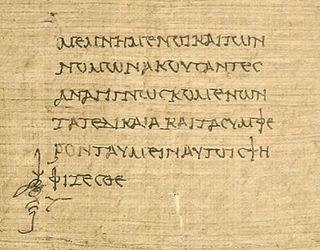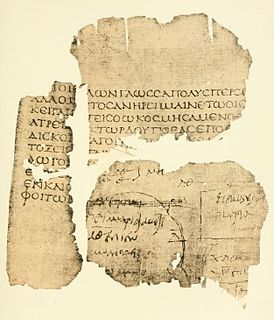
Stichometry is the practice of counting lines in texts: Ancient Greeks and Romans measured the length of their books in lines, just as modern books are measured in pages. This practice was rediscovered by German and French scholars in the 19th century. Stichos is the Greek word for a 'line' of prose or poetry and the suffix '-metry' is derived from the Greek word for measurement.

A coronis is a textual symbol found in ancient Greek papyri that was used to mark the end of an entire work or of a major section in poetic and prose texts. The coronis was generally placed in the left-hand margin of the text and was often accompanied by a paragraphos or a forked paragraphos.

The Oxyrhynchus Papyri are a group of manuscripts discovered during the late nineteenth and early twentieth centuries by papyrologists Bernard Pyne Grenfell and Arthur Surridge Hunt at an ancient rubbish dump near Oxyrhynchus in Egypt.

Papyrus 22, designated by 𝔓22, is an early copy of the New Testament in Greek. It is a papyrus manuscript of the Gospel of John, only containing extant John 15:25-16:2, 21–32. Using the study of comparative writings styles, (palaeography), the manuscript has been dated to the early 3rd century CE. It is the only identified New Testament papyrus to have been written originally as a roll; not a codex or re-using the back of a scroll.
Papyrus 73, designated by 𝔓73, is a copy of the New Testament in Greek. It is a papyrus manuscript of the Gospel of Matthew. The surviving texts of Matthew are verses 25:43; 26:2-3. The manuscript paleographically has been assigned to the 7th century.

Papyrus 74, designated by 𝔓74, is a copy of the New Testament in Greek. It is a papyrus manuscript of the Acts of the Apostles and Catholic epistles with lacunae. The manuscript paleographically had been assigned to the 7th century.
Uncial 0163, is a Greek uncial manuscript of the New Testament, dated palaeographically to the 5th century.
Papyrus Oxyrhynchus 12 is a fragment of a chronological work in Greek. It was discovered by Grenfell and Hunt in 1897 in Oxyrhynchus. The fragment is dated to the first or second century. It is housed in the Cambridge University Library. The text was published by Grenfell and Hunt in 1898.

Papyrus Oxyrhynchus 20 consists of twelve fragments of the second book of the Iliad, written in Greek. It was discovered by Grenfell and Hunt in 1897 in Oxyrhynchus. The fragment is dated to the second century. It is housed in the British Library. The text was published by Grenfell and Hunt in 1898.
Papyrus Oxyrhynchus 21 is a fragment of the second book of the Iliad, written in Greek. It was discovered by Grenfell and Hunt in 1897 in Oxyrhynchus. The fragment is dated to the first or second century. It is housed in the University of Chicago Oriental Institute. The text was published by Grenfell and Hunt in 1898.

Papyrus Oxyrhynchus 23 is a fragment of the ninth book of Plato's Laws, written in Greek. It was discovered by Grenfell and Hunt in 1897 in Oxyrhynchus. The fragment is dated to the third century. It is housed in the Cambridge University Library. The text was published by Grenfell and Hunt in 1898.
Papyrus Oxyrhynchus 24 is a fragment of Chapter X of Plato's Republic, written in Greek. It was discovered by Grenfell and Hunt in 1897 in Oxyrhynchus. The fragment is dated to the third century. It is housed in the Beinecke Rare Book and Manuscript Library at Yale University. The text was published by Grenfell and Hunt in 1898.
Papyrus Oxyrhynchus 28 is a manuscript consisting of fragments of the third book of Hellenica by Xenophon, written in Greek. It was discovered by Grenfell and Hunt in 1897 in Oxyrhynchus. The fragment is dated to the second century. It is housed in the library of the University of St Andrews. The text was published by Grenfell and Hunt in 1898.

Papyrus Oxyrhynchus 211 is a fragment of the Perikeiromene (976–1008) of Menander, written in Greek. It was discovered in Oxyrhynchus. The manuscript was written on papyrus in the form of a roll. It is dated to the first or second century. Currently it is housed in the Houghton Library (3734) of Harvard University.
Papyrus Oxyrhynchus 216 is a rhetorical exercise by an unknown author, written in Greek. It was discovered in Oxyrhynchus. The manuscript was written on papyrus in the form of a roll. It is dated to the first century BC or first century AD. Currently it is housed in the Beinecke Rare Book and Manuscript Library (35) of the Yale University.
Papyrus Oxyrhynchus 219 is a lament for a pet by an unknown author, written in Greek. It was discovered in Oxyrhynchus. The manuscript was written on papyrus in the form of a roll. It is dated to the first century AD. Currently it is housed in the Beinecke Rare Book and Manuscript Library (36) of the Yale University.
Papyrus Oxyrhynchus 223 is a fragment of Homer's Iliad (E,329-705), written in Greek. It was discovered in Oxyrhynchus. The manuscript was written on papyrus in the form of a roll. It is dated to the third century. Currently it is housed in the Bodleian Library in Oxford.
Papyrus Oxyrhynchus 227 is a fragment of the Oeconomicus of Xenophon, written in Greek. It was discovered in Oxyrhynchus. The manuscript was written on papyrus in the form of a roll. It is dated to the first century. Currently it is housed in the British Library in London.
Papyrus Oxyrhynchus 237 consists of a fragment of Petition of Dionysia to the Praefect, written in Greek. They were discovered in Oxyrhynchus. The manuscript was written on papyrus in the form of a roll. It was written after 27 June 186. Currently it is housed in the Bodleian Library.
American Studies in Papyrology is a book series established in 1966 by the American Society of Papyrologists. The series editors are James Keenan (editor-in-chief), Kathleen McNamee, and Arthur Verhoogt.
This page is based on this
Wikipedia article Text is available under the
CC BY-SA 4.0 license; additional terms may apply.
Images, videos and audio are available under their respective licenses.







